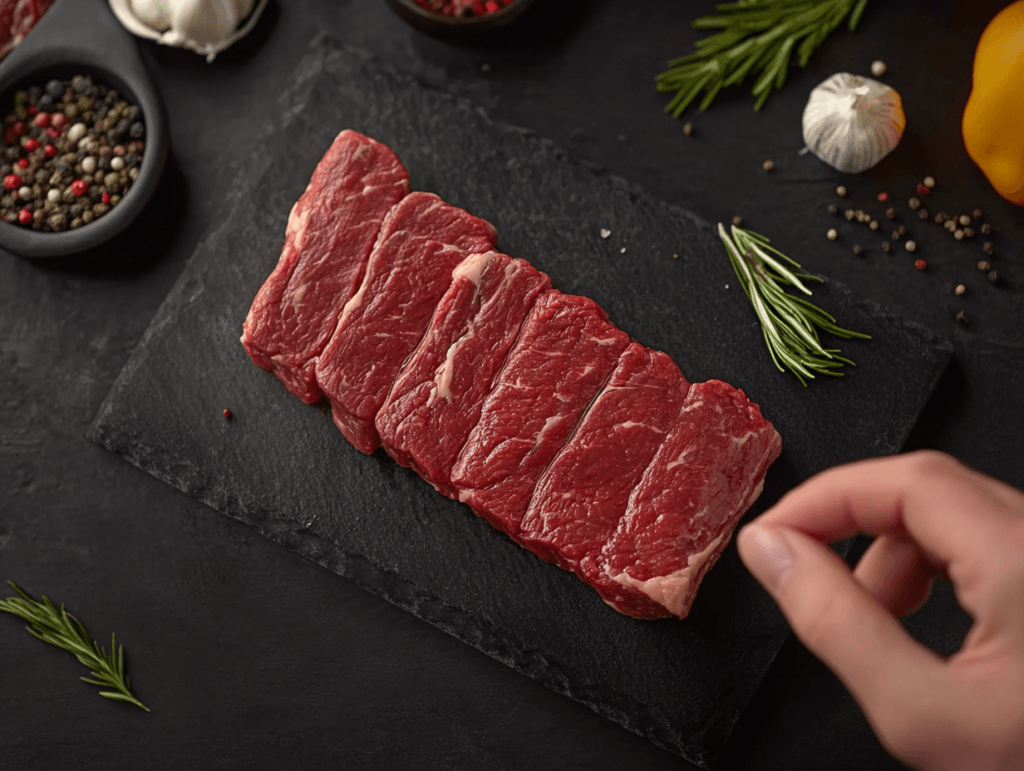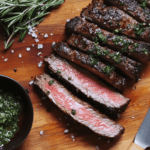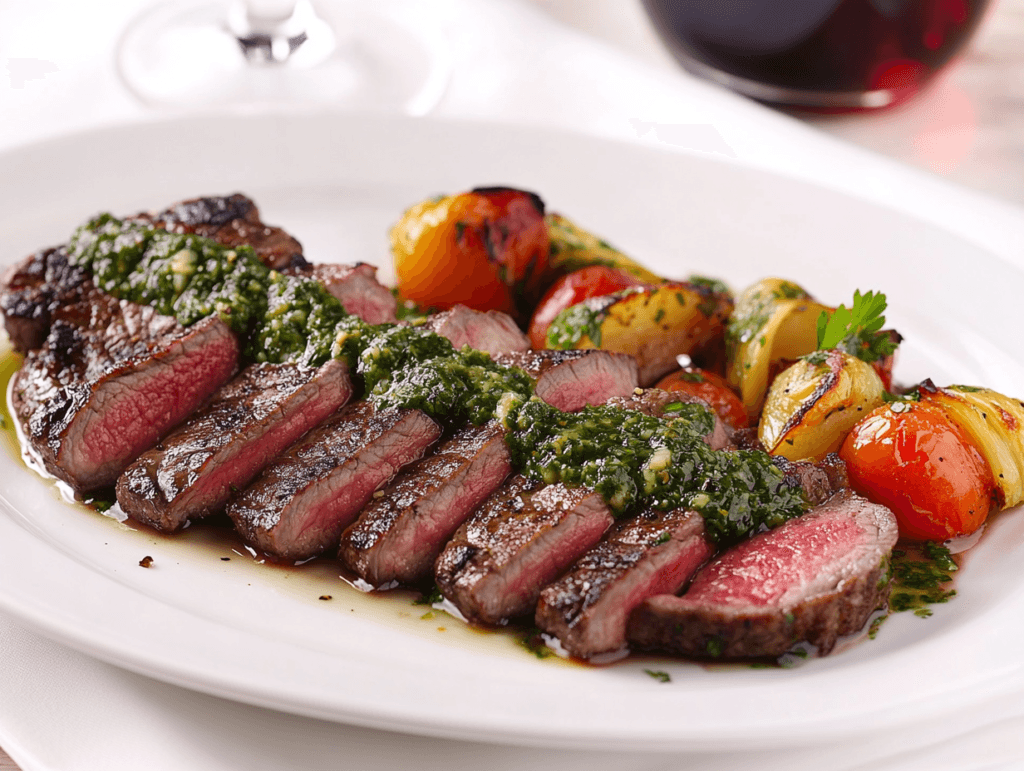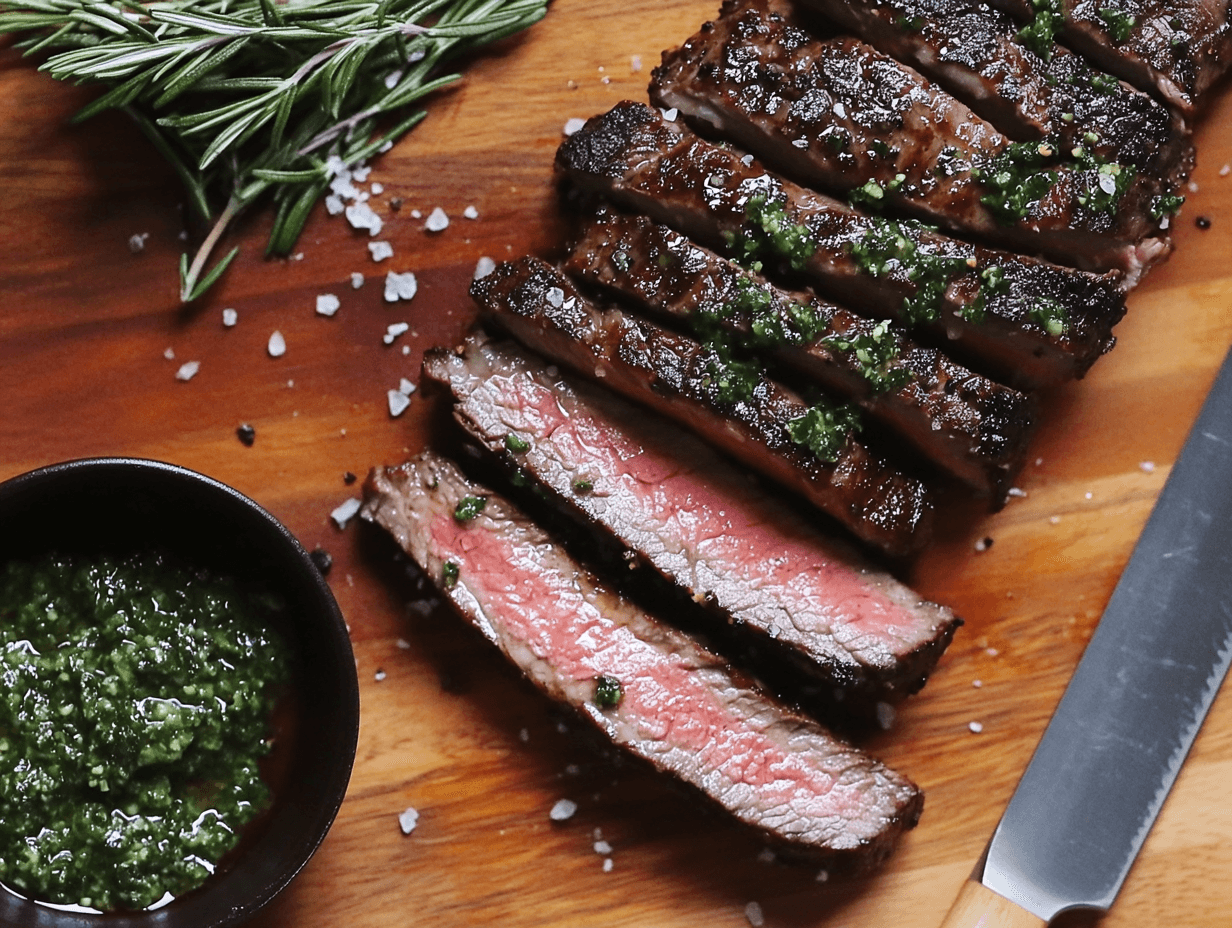Introduction
Have you ever stared at a flat iron steak label, wondering if you’re picking the perfect cut or just settling for an average steak? This label holds the key to understanding everything about this amazing cut of beef. From grading to marbling, the beef loin flat iron steak label helps you make informed choices for your next meal.
The beef loin steak label is a hidden gem—easy to cook, packed with flavor, and surprisingly versatile. Whether you’re firing up the grill or searing it on the stovetop, it’s a steak that delivers big on taste without the fuss. Plus, it’s lean and nutritious, making it a fantastic choice for a filling yet guilt-free indulgence.If you’re interested in a comforting recipe, try this Pepper Lunch Recipe, which pairs perfectly with a flavorful steak meal.
So, why wait? Stick around as we dive into everything you need to know about this incredible cut. You’re going to love how simple, delicious, and fun cooking it can be!


Beef Loin Flat Iron Steak Label: Perfect Cuts and Cooking Tips for Steak Lovers
- Total Time: 20 minutes
- Yield: 2 servings 1x
Description
This beef loin flat iron steak label recipe is the ultimate guide to mastering one of the most underrated cuts of beef. Packed with bold flavor, perfect marbling, and versatility, it’s the steak you’ll come back to again and again.
Ingredients
- 1 beef loin flat iron steak (about 1 lb), USDA Prime or Choice
- 2 tbsp olive oil
- 1 tsp kosher salt
- 1/2 tsp freshly cracked black pepper
- 1/2 tsp garlic powder
- 1 tsp balsamic vinegar (optional)
- Fresh rosemary or thyme sprigs (optional)
Instructions
- Remove steak from the fridge 30 minutes before cooking to bring to room temperature.
- Pat steak dry with paper towels to ensure a great sear.
- Season both sides with salt, pepper, and garlic powder.
- Optional: Marinate in olive oil, balsamic vinegar, and herbs for 30 minutes or overnight.
- Preheat grill or skillet over medium-high heat until sizzling hot.
- Place steak on grill or pan and cook for 4–5 minutes per side for medium-rare.
- Use meat thermometer: 130–135°F for medium-rare, 140°F for medium.
- Remove steak and let it rest 5–10 minutes before slicing.
- Slice against the grain and serve with your favorite sides or sauces.
Notes
Look for USDA grading on the label—Prime or Choice is best. For perfect caramelization, ensure your pan is hot and avoid moving the steak during cooking. Add a drizzle of chimichurri or a pat of garlic butter for an extra burst of flavor.
- Prep Time: 10 minutes
- Cook Time: 10 minutes
- Category: Main Course
- Method: Grilled or Pan-Seared
- Cuisine: American
Nutrition
- Serving Size: 1/2 steak
- Calories: 320
- Sugar: 0g
- Sodium: 520mg
- Fat: 20g
- Saturated Fat: 8g
- Unsaturated Fat: 10g
- Trans Fat: 0g
- Carbohydrates: 1g
- Fiber: 0g
- Protein: 33g
- Cholesterol: 95mg
Keywords: beef loin, flat iron steak, grilled steak, pan-seared steak, steak recipe
Key Ingredients for a Perfect Beef Loin Flat Iron Steak Label
Selecting Fresh Beef Loin Flat Iron Steak Label
Here’s the revised introduction with the focus keyphrase incorporated into the first paragraph:
Choosing the perfect flat iron steak label is like picking a gem from a treasure chest. The label reveals important details, like USDA grading, marbling, and freshness, which help you choose a steak that’s tender, flavorful, and of the highest quality. First, look for a bright red color and fine marbling—those white streaks of fat running through the meat are your best signs of a delicious steak.
Also, pay attention to the USDA grading on the label. Whether it’s “Prime,” “Choice,” or “Select,” each grade indicates a different level of quality. Another tip? Check the expiration date! Freshness makes all the difference. Grass-fed options offer a leaner, earthy flavor, while grain-finished cuts provide richer marbling. Lastly, avoid packages with excess liquid, as it’s a sign the steak might not be as fresh.
When you’re at the store, inspect the flat iron steak label carefully. The better the steak you choose, the better your meal will be!For another great meal idea that emphasizes fresh, high-quality ingredients, check out this savory Traeger Brisket Recipe.
Essential Seasonings and Flavor Enhancers
The secret to making your flat iron steak unforgettable lies in the seasoning. Keep it simple with kosher salt, freshly cracked black pepper, and maybe a touch of garlic powder. These basic spices bring out the natural beefy flavor without overpowering it.
Want to go gourmet? Add a sprig of rosemary or thyme to your marinade. A splash of balsamic vinegar or soy sauce also works wonders for flavor depth. If you’re in the mood for something bold, a chimichurri sauce or a red wine reduction can take your steak to the next level.
But remember, less is often more. Flat iron steak shines when you let its natural flavors do most of the talking. Marinate for at least 30 minutes or, better yet, overnight. You’ll be amazed at how these simple additions can elevate your steak from good to unforgettable.
Step-by-Step Instructions for Beef Loin Flat Iron Steak Label
Preparing the Beef Loin Flat Iron Steak Label
The first step to a perfect steak is preparation. Take your beef loin flat iron steak label out of the fridge at least 30 minutes before cooking. Why? This allows the meat to come to room temperature, ensuring it cooks evenly. While you wait, pat the steak dry with a paper towel. Removing excess moisture is key to achieving that golden, crispy crust you’ll love.For a sweet ending to your steak dinner, try these delightful Lemon Blueberry Cupcakes for a refreshing dessert pairing.
Next, season generously. Use kosher salt and freshly cracked black pepper as your base. Feel free to get creative with additional spices like garlic powder or paprika. Want even more flavor? Marinate your steak in olive oil, soy sauce, and a touch of balsamic vinegar for at least 30 minutes. Trust me, this will add an extra layer of deliciousness.
Lastly, make sure your cooking tools are ready. Preheat your grill or pan to medium-high heat so it’s sizzling hot when you start cooking.

Making the Beef Loin Flat Iron Steak Label
Cooking your beef loin flat iron steak label is where the magic happens. Place the seasoned steak on your preheated grill or skillet. You should hear that satisfying sizzle right away—that’s your sign it’s cooking perfectly.
Cook for about 4–5 minutes on each side for a medium-rare finish. If you prefer it more done, add a minute or two per side. Use a meat thermometer for precision (130–135°F for medium-rare). Flip the steak only once during cooking to keep it juicy.
Once cooked, transfer the steak to a plate and let it rest for 5–10 minutes. Resting allows the juices to redistribute, making every bite tender and flavorful. Slice the steak against the grain for the best texture—it’s like a little hack for melt-in-your-mouth tenderness.
Mastering the Caramelization Process for Beef Loin Flat Iron Steak Label
Selecting Fresh Beef Loin Flat Iron Steak Label
Caramelization starts with a fresh, high-quality steak. Look for a beef loin flat iron steak label with clear USDA grading and fine marbling. The marbling (those streaks of fat) is essential—it melts during cooking, creating that rich, caramelized crust we all crave.
Grass-fed steaks often caramelize differently from grain-finished ones. Grain-fed beef tends to have more marbling, which contributes to a more pronounced crust. Either way, freshness is your priority. Always check for bright red meat and avoid packages with excessive liquid.
Tips for Perfect Caramelization
Getting that beautiful caramelized crust is easier than you think. First, make sure your pan or grill is hot enough—medium-high heat is ideal. A drop of water should sizzle and evaporate instantly when it hits the surface.
Second, avoid overcrowding the pan. If you’re cooking multiple steaks, give each one enough room to breathe. Overcrowding can trap steam, which prevents caramelization.
Lastly, resist the urge to move the steak around too much. Let it sit undisturbed for those critical 4–5 minutes per side. This is how you achieve that golden-brown, slightly crispy exterior that seals in all the juicy goodness.
How to Serve and Present Beef Loin Flat Iron Steak Label
Garnishing and Plating Tips Beef Loin Flat Iron Steak Label
Serving a beef loin flat iron steak label recipe isn’t just about taste—it’s about presentation too. Start by slicing the steak thinly against the grain. This not only makes it easier to eat but also showcases the beautiful pink interior, which adds visual appeal.
Next, think about garnishes. A sprinkle of flaky sea salt or freshly chopped parsley can elevate the look of your dish instantly. Adding a drizzle of chimichurri or a dollop of garlic butter on top not only enhances the flavor but also adds vibrant color.
Plating is your next step. Place your steak slices neatly on a clean plate, and add your sides around it. For a pop of color, try roasted vegetables or a fresh salad. Don’t forget to wipe the edges of the plate for a polished, restaurant-style finish. It’s all about making your meal look as good as it tastes!
Pairing Beef Loin Flat Iron Steak Label with Other Things
The perfect pairing can take your beef loin flat iron steak label dish to the next level. For sides, you can’t go wrong with creamy mashed potatoes or crispy roasted asparagus. Prefer something lighter? A fresh arugula salad with a tangy vinaigrette pairs beautifully.
For beverages, red wine is a classic choice. A bold cabernet sauvignon or a smooth malbec complements the steak’s rich, beefy flavors. Not a wine person? A craft beer or a sparkling water with a slice of lemon works just as well.
Sauces also play a huge role in enhancing your steak. A red wine reduction or a creamy peppercorn sauce can add depth, while a spicy chimichurri or tangy mustard sauce brings a fresh twist. The options are endless, so mix and match to find your favorite combination!
Creative Variations of the Beef Loin Flat Iron Steak Label Recipe
Spicing Up the Classic Beef Loin Flat Iron Steak Label
Sometimes, a little twist on tradition can make a classic even better. To spice up your beef loin flat iron steak label recipe, try experimenting with bold seasonings. Cajun spice rubs or a touch of smoked paprika can add a whole new dimension.
Want to take it further? Add heat with crushed red pepper flakes or a splash of hot sauce in your marinade. You can also play with global flavors. For a Mediterranean vibe, use oregano, garlic, and lemon zest. Craving something Asian-inspired? Try a marinade of soy sauce, ginger, and sesame oil.
The beauty of flat iron steak is its versatility. You can tailor the flavors to suit your taste buds or even the theme of your dinner party. It’s like creating a new masterpiece every time you cook it!
Adding Unique Ingredients to Enhance Flavor
Looking to make your beef loin flat iron steak label stand out? Adding a few unique ingredients can do just that. Consider marinating the steak with a splash of whiskey or red wine to deepen its flavor.
For a nutty twist, sprinkle toasted sesame seeds on top or mix them into your marinade. You can also experiment with unexpected pairings like blue cheese crumbles or a sweet fig glaze. These flavors contrast beautifully with the steak’s savory richness.
For an extra burst of freshness, serve your steak with a side of mango salsa or avocado chimichurri. These unique ingredients not only enhance the flavor but also add a creative flair to your dish, making it a true showstopper.

FAQs
Is flat iron steak a good cut of beef?
Absolutely! Flat iron steak is one of the most tender cuts, second only to filet mignon. It’s prized for its rich, beefy flavor and versatility in cooking. Whether you grill it, pan-sear it, or use it in recipes like tacos or salads, flat iron steak delivers a juicy and satisfying experience every time.
What is flat iron steak called at the grocery store?
At the grocery store, flat iron steak might be labeled as “top blade steak” or simply “flat iron steak.” Some stores might also refer to it as a shoulder cut, as it comes from the chuck (shoulder) area of the cow. Always check the label for specifics like USDA grading or additional details like grass-fed or grain-finished options.
What is the best cooking method for flat iron steak?
Flat iron steak shines when cooked over high heat. Grilling and pan-searing are the most popular methods, as they help develop a caramelized crust while keeping the inside tender and juicy. For the best results, aim for medium-rare to medium doneness, and always let the steak rest before slicing.
Is flat iron a cheap cut?
Yes, flat iron steak is considered an affordable cut of beef, making it a great option for those who want quality without breaking the bank. It offers the tenderness and flavor of pricier steaks like ribeye but at a more budget-friendly price, making it a favorite among home cooks and chefs alike.
Conclusion
Cooking a beef loin flat iron steak label recipe isn’t just about making a meal—it’s about creating an experience. First, you learned how to pick the freshest, most flavorful cuts. Then, we explored the magic of seasoning and caramelization to enhance every bite. Along the way, we shared tips to help you serve and plate your steak like a pro.
Now, you’re equipped with everything you need to make a steak that’s tender, juicy, and downright delicious. Whether you stick to the classic recipe or try some creative variations, you can’t go wrong. Also, remember that this steak pairs beautifully with simple sides and bold sauces.
So, grab your apron and start cooking! You’re going to love how easy and satisfying it is to make. Plus, you’ll impress everyone at the table. Your journey with beef loin flat iron steak label starts now—happy cooking!

